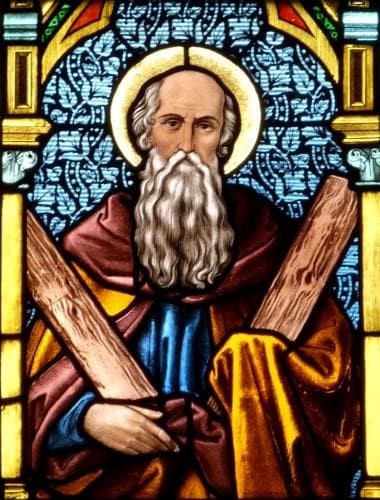Saint Andrew The Apostle
Saint
Feast Day: November 30
Biography
Saint Andrew The Apostle, also known as the First Apostle, was born in Bethsaida, Galilee. He was a fisherman by trade and the brother of Simon Peter. Andrew initially followed John the Baptist and later became a fervent disciple of Jesus Christ.
Throughout his life, Saint Andrew played a pivotal role in leading people to Jesus, sharing the teachings and miracles of the Savior. He remained devoted to Jesus both before and after His crucifixion. As an Apostle, Andrew embarked on numerous missionary endeavors, spreading the Gospel message in various regions.
Saint Andrew is famously recognized for his missionary work in Asia Minor and Greece, and it is believed that he may have also traveled to areas that are now part of modern-day Russia and Poland. During his travels, he faced many challenges and hardships but never wavered in his commitment to share the Good News.
Ultimately, Saint Andrew met his martyrdom in Patras, Greece. He was crucified on a saltire, or x-shaped, cross. Legend has it that he bravely preached from the cross for two days before succumbing to his injuries.
Saint Andrew's Feast Day is celebrated on the 30th of November. Interestingly, his feast day has become associated with several marriage-related superstitions. According to an old German tradition, single women who wish to marry should seek Saint Andrew's help on the eve of his feast and then sleep naked that night, hoping to see their future husbands in their dreams. Another belief suggests that young women should take note of the location of barking dogs on Saint Andrew's Eve, as it is said their future husbands will come from that direction. Additionally, the day after Saint Andrew's feast, young people float cups in a tub, and if a boy's and a girl's cup drift together and are intercepted by a cup inscribed "priest," it is seen as a sign of future marriage.
Saint Andrew holds a special place as the patron saint of Scotland. The connection between Andrew and Scotland dates back centuries. Emperor Constantine the Great decided to transfer Andrew's bones from Patras, Greece, to Constantinople in 345. Legend has it that Saint Regulus of Scotland, after receiving instructions from an angel, brought many of Andrew's relics to the far northwest. He was ultimately guided to stop and found the settlement of Saint Andrew on the Fife coast of Scotland. In the 7th century, Saint Wilfrid of York brought additional relics of Saint Andrew from Rome after his pilgrimage, which were installed at Saint Andrew's Cathedral to enhance the prestige of the new diocese established there. When the Pictish king Angus was faced with a daunting invading army, he prayed for guidance. Subsequently, a white cloud in the form of a saltire cross appeared in the sky, inspiring him to victory. As a result, Angus declared Saint Andrew as the patron saint of Scotland. Following Robert Bruce's victory at the Battle of Bannockburn in 1314, the Declaration of Arbroath officially declared Saint Andrew as the patron saint of Scotland. The saltire, or Saint Andrew's cross, eventually became the national flag of Scotland in 1385.
Saint Andrew is revered as the patron saint against various ailments, including convulsions, fever, gout, neck pain, stiff neck, torticollis, sore throats, and whooping cough. He is also acknowledged as the patron saint of anglers, boatmen, butchers, farm workers, fish dealers, fishmongers, fishermen, happy marriages, maidens, mariners, miners, old maids, pregnant women, rope makers, sailmakers, sailors, single laywomen, singers, spinsters, textile workers, unmarried women, water carriers, and women who wish to become mothers. He is honored by numerous organizations and institutions worldwide, including the Dames of Saint Andrew, the Karađorđević dynasty, the Knights of the Golden Fleece, the Knights of Saint Andrew, the Order of the Thistle, the Spanish armed forces, the University of Patras, the Worshipful Company of Glaziers and Painters of Glass, and the Worshipful Company of Makers of Playing Cards.
Various dioceses, cities, and towns commemorate Saint Andrew as their patron saint. Some of these include Amalfi-Cava de 'Tirreni, Italy; Constantinople; Grand Rapids, Michigan; Little Rock, Arkansas; and Victoria, British Columbia. Furthermore, Saint Andrew is venerated in numerous regions around the world, such as Austria, Barbados, Germany, Greece, Luxembourg, Netherlands, Romania, Russia, Scotland, Spain, and Ukraine.
Saint Andrew is commonly depicted in various artistic representations. These include images of him fishing, holding a fishing net, preaching from a cross, an old man with long white hair and a beard, holding the Gospel in his right hand and leaning on a transverse cross, a preacher holding some fish, and the symbol of Saint Andrew's cross or saltire.
Despite the destruction of Saint Andrew's relics by Protestants around 1559, his life and teachings continue to inspire countless individuals and communities. Saint Andrew The Apostle's unwavering faith, missionary zeal, and commitment to the Gospel exemplify his remarkable contribution to the early Christian Church and his enduring impact on the spiritual heritage of believers around the world.
